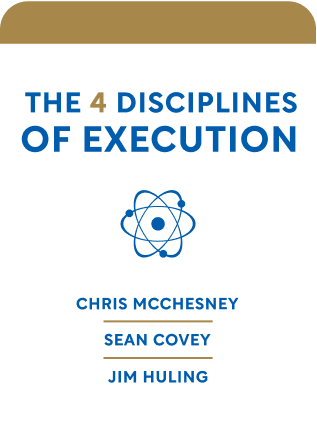

This article is an excerpt from the Shortform book guide to "The 4 Disciplines of Execution" by Chris McChesney, Sean Covey, and Jim Huling. Shortform has the world's best summaries and analyses of books you should be reading.
Like this article? Sign up for a free trial here .
How often have you or your organization come up with an amazing plan, showed it off, admired it, been sure that it’s the solution to all your problems—only to have it die a slow death over the following months? In hindsight, what do you think prevented you from putting your plan into motion?
In their book The 4 Disciplines of Execution, Chris McChesney, Jim Huling, and Sean Covey say this isn’t uncommon, because strategy (making the perfect plan) is much easier than execution (actually carrying out your plan). McChesney, Huling, and Covey’s system—or 4 Disciplines—addresses this challenge with a framework for achieving important goals in spite of the deluge of day-to-day activities necessary to keep an organization running.
Below is a brief overview of McChesney, Huling, and Covey’s 4 Discipline system and how to implement each at an organizational level.
The 4 Disciplines of Execution: Achieving Your Wildly Important Goals
When you want to make a change, you come up with a strategy. That’s the easy part—next, you have to figure out how to implement the strategy. In their book The 4 Disciplines of Execution, Chris McChesney, Jim Huling, and Sean Covey present four disciplines that allow you to carry out your strategy. When you apply focus, leverage, engagement, and accountability, not only will you execute your strategies, you’ll create permanent behavioral changes as a leader and an organization.
| Overcome the Deluge With the Eisenhower Matrix The Eisenhower Matrix, a time management tool developed by former US president Dwight Eisenhower and popularized by Stephen Covey, is a systematic way of prioritizing the deluge of day-to-day activities. The Eisenhower Matrix divides tasks into four categories and gives advice about how to handle each category: Urgent and important: Do it. If you have a task that’s both pressing and significant, you should get it done as soon as possible. Examples include filing time-sensitive reports and attending (some) meetings. Important, but not urgent: Schedule it. If there’s something that you need to do, but don’t need to do right now, make a plan for when and how you’ll handle it. Examples include employee reviews, team-building activities, and planning sessions. Your work with the 4 Disciplines will fall into this category. Urgent, but not important: Delegate it. Eisenhower defined this category as tasks that need to be done, but that don’t require you, personally, to do them—hence his suggestion of delegating those tasks to somebody else. In First Things First, Covey says these are tasks that you trick yourself into wasting time on because you mistake time-sensitive tasks for important tasks. Either way, this category is a dangerous time sink and an excellent place to start if you’re trying to free up some time for more important tasks. Which of the tasks in your company’s day-to-day deluge fall into this category? Neither urgent nor important: Ignore it. Tasks that aren’t significant or time-sensitive are, almost by definition, things that you can safely ignore. Examples might include going through old emails or scrolling social media. |
Besides helping you achieve a specific goal, the 4 Disciplines also create behavioral changes that permanently raise an organization’s overall level of performance. Furthermore, the authors claim that their system works for any kind of team, no matter the team structure or the industry; it even works in personal or family settings.
McChesney, Huling, and Covey are executives and consultants for FranklinCovey, a leadership and consulting firm. The 4 Disciplines of Execution is based on their observations and methods. FranklinCovey also offers services in teaching and implementing the 4 Disciplines.
In this guide, we’ll connect the authors’ ideas with those from other popular self-help and business guides such as Awaken the Giant Within and Smarter Faster Better. We’ll also examine where the authors’ methods may be incomplete or unproven in practical settings. Taken together, this guide will provide the background and tools to effectively tackle the processes within this book.
| The Wire Cable of Discipline The authors chose the word “disciplines” to let us know that implementing these changes will require hard work and consistent effort. In The Monk Who Sold His Ferrari, Robin Sharma says that we can picture discipline as a wire cable—numerous small wires braided together like a rope. Individually, each wire is weak and easily broken; when they’re all together, they create a strong cable. In the same way, numerous small practices and habits reinforce one another to create the discipline and inner strength to carry out your plans and achieve your goals. The introduction of The 4 Disciplines of Execution says something similar: The authors assert that the 4 Disciplines’ greatest benefits come from how they all work together, leading to much greater gains in productivity than if you tried to apply any one discipline on its own. Much of this book (and therefore this guide) is devoted to practical techniques and principles you can use to start creating your own wire cable of discipline. |
Discipline 1: Focus
In Discipline 1, you will choose which goals to make your top priorities—ideally one or two goals, three at the absolute most. The authors call these “Wildly Important Goals (WIGs)” in order to emphasize that they should be your primary focus. The authors add that choosing so few goals may feel counterintuitive, but narrowing your focus is crucial for success because the human mind can only devote its best efforts to one thing at a time.
(Shortform note: Although the authors begin this book by separating strategy and execution, in Section 1 they acknowledge that the lines between the two are blurred—that a good strategy must, by definition, be executable. That’s why the first of their 4 Disciplines is about setting effective goals and devoting the proper amount of energy to them, which is generally considered to be part of strategy, not execution. In other words, in order to execute your strategy, you must first make sure that your strategy is a good one.)
For an organization, senior leaders choose the main goal or goals. Then, each team comes up with its own goals to support the organizational goal.
McChesney, Huling, and Covey give four rules for choosing team goals:
- Rule #1: No team may choose more than two goals.
- Rule #2: Team goals must directly support the overall goal.
- Rule #3: Teams get to choose their own goals. Senior leaders can veto goals they don’t feel will support the organization, but they cannot choose the team’s goal.
- Rule #4: All goals must include an end point, expressed as follows: “From (current situation) to (desired situation) by (deadline).”
Having laid out four rules for goals, the authors suggest choosing goals by following these four steps:
1. Brainstorm. Ask yourself what kind of change would have the most impact on your organization or team. Consider things that aren’t working and things that, if they worked even a little better, would have a large impact. Involve peer leaders and your team in the brainstorming.
(Shortform note: Most people are familiar with brainstorming, but the person who invented the process—advertising executive Alex Osborn—included a step that many people overlook: Combine and improve the ideas. In other words, many “brainstorming” sessions consist entirely of people throwing ideas at the wall to see what sticks, but true brainstorming means looking for common ground between those ideas and seeing how they can build upon each other.)
2. Appraise. Consider the list of team goals you brainstormed. Which ones will have the highest impact on the company goal?
(Shortform note: You might reasonably be concerned about picking the wrong goal or goals—what if your appraisal is flawed, or the market situation changes? To combat this fear, bear in mind that Rework authors David Heinemeier Hansson and Jason Fried say that the single most dangerous thing you can do in business is fail to make a decision. A bad decision—such as choosing the wrong goal to pursue—can always be reevaluated and changed; a non-decision leaves you stuck, with no feedback to help you choose a wiser course of action.)
3. Check. Make sure that the goal you’ve picked is reasonable. The authors’ criteria for a reasonable goal are: The goal must support the company’s overall goal, must be measurable, must be driven by the team rather than the leader, and shouldn’t depend more than 20% on another team.
(Shortform note: It will be tempting to set easily achievable goals that you can feel good about accomplishing, but it can be more effective to set ambitious goals, or even impossible ones. In Awaken the Giant Within, Tony Robbins explains that setting big goals inspires you to work harder than setting goals you’re confident about reaching—so long as you work with the mindset that progress toward your goal constitutes success, and falling short of the goal is not failure.)
4. Write. Choose your goal and write it in the format specified in Rule #4: “From (current situation) to (desired situation) by (deadline).”
(Shortform note: Writing down goals isn’t just for recordkeeping, it also makes you more likely to follow through and achieve those goals—20% to 40% more likely, according to one study. This is because when you write something down, you’re more likely to retain it and consider it important than if you just trust yourself to remember your goal.)
Discipline 2: Leverage
Discipline 2 focuses on getting from your current situation to the desired situation you defined in Discipline 1. McChesney, Huling, and Covey call this Discipline “leverage” because it’s about using your effort more effectively. Instead of trying to push a big, heavy goal directly, you channel your energy into related goals that you can actually influence, which in turn moves your company closer to its main goal (like using a lever to move a heavy rock instead of trying to lift it yourself).
The authors say one major problem with implementation is that people generally measure results. Butresults, or lag measures, are fixed—they can’t change once they’re measured, and they don’t give you any information on how to proceed. For example, if your goal is to save up a certain amount of money, your only measurement might be the number in your bank account: If it’s lower than your goal, you don’t learn anything about how to increase it.
That’s why McChesney, Huling, and Covey recommend that you find a way to measure your efforts, or lead measures, rather than just your results. So, if you’re trying to save money, you might measure how many hours you worked in a week and how much money you spent during that week (results). But if you focus on working more and spending less (increasing your efforts), you’ll naturally reach your goal of saving up money—this is much more effective than simply checking your bank account and hoping that it’s higher than before.
The authors explain that whatever lead measures you use must have two essential characteristics: It must be predictive (a change in the effort will yield a change in the results) and it must be influenceable (your team must be able to directly impact the measurement without relying on other teams).
So, how do you choose good effort measurements for a team or a company? The authors suggest using the same four steps that you used for goal setting.
- Brainstorm: Ask yourself what kind of changes would affect your team’s goal or goals. Consider things you’ve never done before, things you could improve, and things you’re doing badly that might hamper you. Look at successful companies’ measures for inspiration. Involve your team in the brainstorming.
- Appraise: Consider the list of effort measures you brainstormed. Which ones will have the most effect on your team’s goals?
- Check: Your effort measure must be predictive, maintainable, measurable, and impactful. It must have an effect on the team goal, be driven by the team rather than the leader, and it must be influenceable—your team needs to have control over it—so it shouldn’t depend more than 20% on another team.
- Write: The effort measure statements don’t have a strict format like a goal statement, but they should still be specific, start with a simple verb, and be concise. They should be clear about expectations—does the lead measure need to be done daily or weekly? How often, how much, and how well? Are they concerned with team or individual performance?
Discipline 3: Engagement
In Discipline 3, the authors tell you to engage your team by making the 4 Disciplines into a game that they can win. You already did some engagement work in the previous two disciplines by consulting your team members about the team goal and lead measures. When people choose their own goals and feel ownership, they’re more engaged. They’re also more engaged when they enter a competition their team can win—humans have a natural urge to compete and love to win.
McChesney, Huling, and Covey suggest designing a scoreboard to go with the game; better yet, have your employees design and create it. This scoreboard must tell your team if they’re winning (if they’re on track to meet the goal), and it’s a constant reminder of the game you’re all trying to win. For example, the scoreboard might be a graph with two lines: one that goes from your starting situation to your desired situation over the time allotted (as stated in Discipline 1) and another that shows your actual progress toward that goal.
The authors recommend creating a separate visual for your effort measurement—perhaps a chart where each team member tracks what they’ve accomplished so far that week.
Discipline 4: Accountability
In Discipline 4, the authors recommend holding a weekly accountability meeting—what they call a WIG (Wildly Important Goal) session. Because achieving the goal is now a game, people are accountable to their teammates as well as the boss. When people know others are depending on them, they’re more motivated and engaged, they try harder, and performance becomes a matter of personal pride. Regular goal sessions and mandatory attendance are key to this discipline—accountability requires consistency.
According to the authors, the goal session should take place at least once a week, last less than 30 minutes, and have a specific agenda: Review the scoreboard, report on last week’s commitments (and celebrate them), and come up with new commitments.
McChesney, Huling, and Covey say that goal session commitments must influence your current effort measurements (deluge tasks—the endless day-to-day business of running the company—do not belong in these meetings). Commitments must be focused, specific, impactful, and take no longer than a week to complete. The person who makes the commitment must be able to do most of the work themselves.
The authors add that leaders should make weekly commitments too. The most effective commitments for leaders are ones that help their team achieve their individual commitments and improve their execution. For example, if a team member requires a new piece of software, a leader could secure approval for the purchase.
Implement the 4 Disciplines at the Organizational Level
The authors provide six steps to implement the 4 Disciplines across an entire organization:
- Choose the overall goal. Use the steps in Discipline 1.
- Choose team goals and lead measures. Use the steps in Disciplines 1 and 2.
- Train leaders in the 4 Disciplines. The training covers what the disciplines are, how to teach and communicate them to their teams, how to solicit feedback, and roleplay practice. The authors have free resources for doing this on their site, and also offer paid consulting and training services.
- Launch the program. Team leaders hold a two-hour launch meeting with their respective teams, during which they explain what the 4 Disciplines are, communicate and solicit feedback on the goals and lead measures, and explain the scoreboard.
- Guided execution. Someone deeply familiar with the 4 Disciplines helps everyone through the weekly practice of attending goal sessions, making commitments, and keeping score.
- Quarterly meetings. Every few months, leaders attend a leader version of a goal session. Each team leader will discuss their team’s progress, and they can also be recognized for their successes.
| Overcome Resistance to Change One thing McChesney, Huling, and Covey don’t explicitly address in this process is the need to get people on board with the new direction you’re taking. Major changes in company or team processes (such as implementing the 4 Disciplines) often lead to pushback from employees and team members. Heading off that resistance—and dealing with it if it does arise—can be key to successfully implementing the 4 Disciplines and other major changes. Here’s one method of overcoming opposition to change: Raise awareness. Get people talking about the change, even if what they have to say about it isn’t good at first. Allow your employees to have intense discussions about it, and welcome criticism and feedback. Explain why. Once employees know what is happening, tell them why it’s happening; how the new process will benefit them and the company as a whole. Adjust the process. Take employee feedback seriously, especially from the ones who are most opposed to the change. Addressing their concerns can often make a good change even better, and they’ll feel more engaged with the process if they’re able to contribute to it. Acknowledge past mistakes. If your company has a history of making bad changes, even if you had nothing to do with those changes, you may have trouble convincing employees or team members that this new process will be for the best. The best way to overcome past failures is to admit to them and, if possible, to correct the past mistakes. |
Benefit From Permanent Behavioral Changes
As your team and organization move through the 4 Disciplines process, the behaviors your team members have adopted in each Discipline (like engagement and accountability) will start to become habit.
The authors say there are five stages of behavioral change during this process:
- Set the stage. In this stage, your team gets involved in choosing the team goal and lead measures and settling on a time for the weekly goal session.
- Begin the process. Officially launch the program. The top 20% of your team will get on board right away, 20% will resist, and 60% will be somewhere in the middle. Make sure everyone keeps following the process and, as the leader, demonstrate commitment to the method.
- See good results. Once your team starts to see results, they’ll stop being so resistant to the new changes, become more engaged with the process, and become more accountable for their own contributions to it.
- See even better results. Now the team members are actively changing their behavior, often even more than the lead measurements require. The whole team’s performance improves.
- The 4 Disciplines are second nature. By the time your team achieves its goal, the behaviors they adopted to reach it will be habits. Your team will be well-prepared for the next challenge, and the achieved goal goes back into the daily deluge.
| Counterpoint: Don’t Get Complacent It’s not always enough to go through an organizational change like the 4 Disciplines and trust that the changes will stick. That’s why the business fable Our Iceberg Is Melting has another step after you reach your goal: Don’t get complacent. Rather than patting yourself on the back and going back to business as usual, Iceberg authors Holger Rathgeber and John Kotter say there are two necessary things to make sure your organization continues to benefit from the work your team did: Make sure the changes will stick. The authors of 4 Disciplines are confident that people will naturally keep using their method—however, it’s more effective to officially write the process and expectations into your company or team policy. Doing so will ensure that employees (even those who weren’t involved in the process the first time) will know how to effectively set and reach goals and why it’s important to do so. Be ready to do it again. There will always be changes to adapt to and new goals to strive for, so you must always be ready to go through the 4 Disciplines again. The good news is that it will be easier after the first time, because your employees will (mostly) be familiar with the process and will have seen that it’s effective—therefore, there will be less resistance and less time lost to teaching the process. |

———End of Preview———
Like what you just read? Read the rest of the world's best book summary and analysis of Chris McChesney, Sean Covey, and Jim Huling's "The 4 Disciplines of Execution" at Shortform .
Here's what you'll find in our full The 4 Disciplines of Execution summary :
- The 4 disciplines that can make any strategy a successful reality
- Why a great plan falls apart when you don't think adequately about execution
- The 6 steps you need to scale the 4DX model across an entire organization






